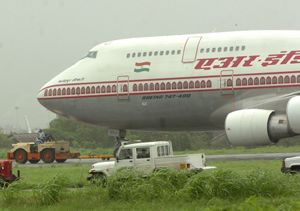
New Delhi, August 17: In an unprecedented whistleblowing act, former Indian Airlines chief Sunil Arora wrote to the then cabinet secretary B K Chaturvedi in May 2005 complaining that he and the IA board were being pressured by then civil aviation minister Praful Patel and his OSD to take financially damaging and commercially unviable decisions.
In his May 28, 2005, letter, Arora listed the decisions on which the board was overruled: purchasing more jets than required, disallowing IA to fly on viable routes to make way for other operators and, even "changing the seating configuration" to favour a particular aircraft manufacturer.
Two Lok Sabha MPs, Prabodh Panda (CPI) andNishikant Dubey (BJP) have now approached the CVC for a probe into Arora's allegations, saying the government has failed to act.
"I would like to place before you a series of events and certain directions given to me by my immediate superior officer and the minister of civil aviation which have a vital bearing on certain critical decisions being taken in Indian Airlines and Air India... I have been constrained to write in detail to be able to explain the nuances of the verbal directions, the infirmities in the subsequent decisions taken and my consequent sense of unease in the matter," Arora wrote.
He also expressed apprehension over the consequence of his action. "Sir, kindly pardon my impertinence but I implore you to share the contents of this communication only with the Prime Minister... I would not have taken the liberty of making such a suggestion but for the fact that like every mortal, I fear for my personal and family safety."
Complaining of pressure, Arora said, "During the last one year, almost all board meetings of Air India, and even some board meetings of Airports Authority of India have become a farce. Instructions on key agenda items are communicated before hand on telephone or personally by minister, civil aviation, or by his OSD K N Choubey. No suggestions to the effect, that the issue in question requires a more detailed examination or that there are some implications are countenanced. The key word is 'immediate and unquestioned compliance'." Some of the most glaring instances are cited:
"AI discussed their dry leasing plans in 99th board meeting held in Mumbai on 17.7.04. Prior to this meeting, minister spoke to me... said since he and secretary, civil aviation, were satisfied about the correctness of the plans, it is expected that we should immediately endorse it during the board meeting. When I tried to tell him on telephone that the agenda item raises some issues, I was curtly asked to endorse the proposal and a counter question was posed on the telephone that when the minister and the secretary himself are satisfied, what more is there for us to see?"
Arora further wrote that the minister forced him to seek flight slots for IA to the UK and the US during the winter schedule instead of the profitable summer schedule even as private airlines were allowed to fly to these destinations in the summer.
"There is a clear mismatch between the reply given before the members of Parliament and the real facts. On 18.01.05, I got a message to immediately speak to the minister on telephone at his Mumbai landline... There was a conversation which went on for 15 to 20 minutes and minister civil aviation clearly told us not to file for flights to London, for the summer schedule 2005. He started by saying that since Indian Airlines does not have wide-bodied aircraft, it would not be advisable for Indian Airlines to apply for the slots at this stage.
I politely remonstrated that none of the other airlines, which have been permitted to go abroad viz Jet and Sahara, had wide-bodied aircraft till that time and if they can be considered for flights to London, Indian Airlines being the national carrier, should at least be given equal footing, if not precedence. The response on the other side was that, Indian Airlines should apply for flights to London or for other UK and US destinations only from the winter schedule."





Comments
Add new comment